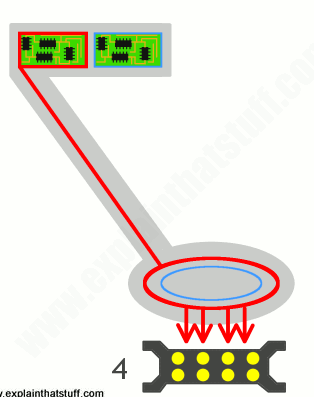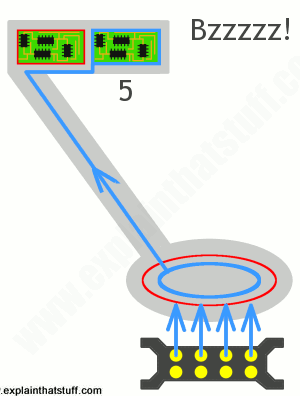Metal Detectors: Difference between revisions
No edit summary |
No edit summary |
||
| (42 intermediate revisions by the same user not shown) | |||
| Line 1: | Line 1: | ||
Claimed by Kristie Choe | |||
'''Short Description of Topic''' | '''Short Description of Topic''' | ||
| Line 13: | Line 15: | ||
The metal detector is able to detect this new magnetic field because of the receiver coil that is connected to a circuit with a loudspeaker. When the detector moves around the metal object, the induced magnetic field on the object cuts through the coil, causing electricity to flow through the receiver coil, which makes the loudspeaker beep or click. The closer the transmitter coil is to the object, the louder the noise will be from the receiver coil. | The metal detector is able to detect this new magnetic field because of the receiver coil that is connected to a circuit with a loudspeaker. When the detector moves around the metal object, the induced magnetic field on the object cuts through the coil, causing electricity to flow through the receiver coil, which makes the loudspeaker beep or click. The closer the transmitter coil is to the object, the louder the noise will be from the receiver coil. | ||
===A Mathematical Model=== | |||
Faraday's Law, which states <math>\mathcal{E} = -{{d\Phi_B} \over dt} \ </math>, where <math>\mathcal{E}</math> is the emf produced from the time-varying magnetic flux Φ<sub>''B''</sub>. The flux is given by <math> \int_{\Sigma} \mathbf{B} \cdot d\mathbf{A}. </math> | |||
=== | The figure below shows a sketch of the effect of a metal object on the magnetic flux when placed in the vicinity of the receiver coil. | ||
[[File:Textbook.png]] | |||
Applications of Faraday's Law and Biot-Savart Law in finding magnetic flux and emf: | |||
Emf induced in the pick-up coil: | |||
<math>\mathcal{E} = -N_p{{d\Phi} \over dt} \ </math> | |||
<math>\mathcal{\Phi}</math> is the magnetic flux in the receiver coil due to the magnetic field produced by the transmitter coil | |||
<math>N_p</math> is the number of turns in the receiver coil | |||
Biot-Savart Law gives magnitude of the magnetic field at the center: | |||
<math>B = N_f{\mu_0}I(t)/(2R_f)</math> | |||
<math>{{\mu_0}}= 4{\pi}{E-7}</math> is the vacuum permeability constant | |||
<math>N_p</math> is the number of turns in transmitter coil | |||
<math>R_f</math> is the radius of the transmitter coil | |||
Approximate magnetic flux of the receiver coil: | |||
<math>\mathcal{\Phi} = ({\pi}R_p^2)N_f{{\mu_0}}I(t)/(2R_f)</math> | |||
Emf induced in receiver coil: | |||
<math>\mathcal{E} = {{\mu_0}}N_pN_f{\pi}R_P^2/(2R_f) {dI(t) \over dt} \ </math> | |||
===A Visual Model=== | |||
1. The transmitter coil (red circle) is connected to a circuit (red). | |||
2. The transmitter coil induces a magnetic field around it. | |||
3. When the detector moves across a metal object (3), the magnetic field cuts through it. | |||
4. The magnetic field induces an electrical current flow inside the metal object (yellow). | |||
5. This electric field creates a second magnetic field around the metal object (blue arrows), which cuts through the receiver coil (blue circle). This, in turn, causes an electric current to flow through the receiver coil and into the circuit (blue) at the top, making a noise. | |||
[[File:visual123.png]] [[File:visual4.png]] [[File:visual5.png]] | |||
==Examples of metal detector models== | |||
[[File:Simpledetector.png]] [[File:newdetector.jpg]] | |||
==Connectedness== | ==Connectedness== | ||
This is a topic that I am interested in because I have always wanted to own a metal detector. It is eye-opening to see how the physics I have been learning this semester relates to this device when I never thought twice about how it works. Metal detectors have many applications other than just as metal detectors to look for valuable items, but they can also be used for things such as security purposes to screen for dangerous weapons and the like. | |||
==History== | ==History== | ||
The metal detector was invented out of necessity. On July 2, 1881, President James Garfield was shot in Washington, D.C. by a man named Charles J. Guiteau. The President was shot in the back but it was not life-threatening, but the bullet could not be found and it was causing the President to suffer. When Alexander Graham Bell visited the President during this time, he built a metal detector to be able to find this bullet. Unfortunately, the device was unsuccessful due to metal springs in the President's bed that were confusing the device unbeknownst to Bell. President Garfield died of the wound infection on September 19, 1881. | |||
Bell's invention was a prototype to later inventions used to find and clear landmines and unexploded bombs across Europe after both world wars. Then Gerhard Fisher created the first portable metal detector in 1925, but Charles Garrett, an electrical engineer, started metal detecting as a hobby, also reinventing metal detector design at the time. | |||
== See also == | == See also == | ||
[http://www.physicsbook.gatech.edu/ | [http://www.physicsbook.gatech.edu/Biot-Savart_Law Biot-Savart Law] | ||
[http://www.physicsbook.gatech.edu/ | [http://www.physicsbook.gatech.edu/Magnetic_Force Magnetic Force] | ||
[http://www.physicsbook.gatech.edu/Faraday%27s_Law Faraday's Law] | [http://www.physicsbook.gatech.edu/Faraday%27s_Law Faraday's Law] | ||
| Line 57: | Line 88: | ||
[http://www.physicsbook.gatech.edu/Inductance Inductance] | [http://www.physicsbook.gatech.edu/Inductance Inductance] | ||
==References== | |||
=== | |||
[http://www.explainthatstuff.com/metaldetectors.html/ http://www.explainthatstuff.com/metaldetectors.html] | |||
[http://inside.mines.edu/~jamcneil/TPT_MetalDetector.pdf/ http://inside.mines.edu/~jamcneil/TPT_MetalDetector.pdf] | |||
[ | [http://www.metaldetector.com/learn/metal-detector-history/history-of-the-metal-detector/ http://www.metaldetector.com/learn/metal-detector-history/history-of-the-metal-detector] | ||
Latest revision as of 02:35, 4 December 2015
Claimed by Kristie Choe
Short Description of Topic
Introduction to the invention of metal detectors and the physics behind the tool.
The Main Idea
Metal detectors are electromagnetic devices using Faraday's Law used to sense the presence of metal within its reach.
How They Work
Simple metal detectors have two types of coils: transmitter coils, coils of wire wrapped around the typically circular head at the end of the device's handle and receiver coils. According to Maxwell's equations, as the electricity flows through the transmitter coil and creates an electric field, so too does a magnetic field occur all around it as well. It is necessary for the user to move the detector across the ground so that the magnetic field will move around too. By moving the detector over a metal object, the moving magnetic field around the detector affects the atoms inside the metal, causing the electrons to move in a different manner. Simply put, the detector's moving magnetic field induces electrical activity in the metal object, in turn, now causing another magnetic field to appear around the metal object.
The metal detector is able to detect this new magnetic field because of the receiver coil that is connected to a circuit with a loudspeaker. When the detector moves around the metal object, the induced magnetic field on the object cuts through the coil, causing electricity to flow through the receiver coil, which makes the loudspeaker beep or click. The closer the transmitter coil is to the object, the louder the noise will be from the receiver coil.
A Mathematical Model
Faraday's Law, which states [math]\displaystyle{ \mathcal{E} = -{{d\Phi_B} \over dt} \ }[/math], where [math]\displaystyle{ \mathcal{E} }[/math] is the emf produced from the time-varying magnetic flux ΦB. The flux is given by [math]\displaystyle{ \int_{\Sigma} \mathbf{B} \cdot d\mathbf{A}. }[/math]
The figure below shows a sketch of the effect of a metal object on the magnetic flux when placed in the vicinity of the receiver coil.
Applications of Faraday's Law and Biot-Savart Law in finding magnetic flux and emf:
Emf induced in the pick-up coil: [math]\displaystyle{ \mathcal{E} = -N_p{{d\Phi} \over dt} \ }[/math]
[math]\displaystyle{ \mathcal{\Phi} }[/math] is the magnetic flux in the receiver coil due to the magnetic field produced by the transmitter coil
[math]\displaystyle{ N_p }[/math] is the number of turns in the receiver coil
Biot-Savart Law gives magnitude of the magnetic field at the center:
[math]\displaystyle{ B = N_f{\mu_0}I(t)/(2R_f) }[/math]
[math]\displaystyle{ {{\mu_0}}= 4{\pi}{E-7} }[/math] is the vacuum permeability constant
[math]\displaystyle{ N_p }[/math] is the number of turns in transmitter coil
[math]\displaystyle{ R_f }[/math] is the radius of the transmitter coil
Approximate magnetic flux of the receiver coil:
[math]\displaystyle{ \mathcal{\Phi} = ({\pi}R_p^2)N_f{{\mu_0}}I(t)/(2R_f) }[/math]
Emf induced in receiver coil:
[math]\displaystyle{ \mathcal{E} = {{\mu_0}}N_pN_f{\pi}R_P^2/(2R_f) {dI(t) \over dt} \ }[/math]
A Visual Model
1. The transmitter coil (red circle) is connected to a circuit (red).
2. The transmitter coil induces a magnetic field around it.
3. When the detector moves across a metal object (3), the magnetic field cuts through it.
4. The magnetic field induces an electrical current flow inside the metal object (yellow).
5. This electric field creates a second magnetic field around the metal object (blue arrows), which cuts through the receiver coil (blue circle). This, in turn, causes an electric current to flow through the receiver coil and into the circuit (blue) at the top, making a noise.
Examples of metal detector models
Connectedness
This is a topic that I am interested in because I have always wanted to own a metal detector. It is eye-opening to see how the physics I have been learning this semester relates to this device when I never thought twice about how it works. Metal detectors have many applications other than just as metal detectors to look for valuable items, but they can also be used for things such as security purposes to screen for dangerous weapons and the like.
History
The metal detector was invented out of necessity. On July 2, 1881, President James Garfield was shot in Washington, D.C. by a man named Charles J. Guiteau. The President was shot in the back but it was not life-threatening, but the bullet could not be found and it was causing the President to suffer. When Alexander Graham Bell visited the President during this time, he built a metal detector to be able to find this bullet. Unfortunately, the device was unsuccessful due to metal springs in the President's bed that were confusing the device unbeknownst to Bell. President Garfield died of the wound infection on September 19, 1881.
Bell's invention was a prototype to later inventions used to find and clear landmines and unexploded bombs across Europe after both world wars. Then Gerhard Fisher created the first portable metal detector in 1925, but Charles Garrett, an electrical engineer, started metal detecting as a hobby, also reinventing metal detector design at the time.
See also
References
http://www.explainthatstuff.com/metaldetectors.html
http://inside.mines.edu/~jamcneil/TPT_MetalDetector.pdf
http://www.metaldetector.com/learn/metal-detector-history/history-of-the-metal-detector





